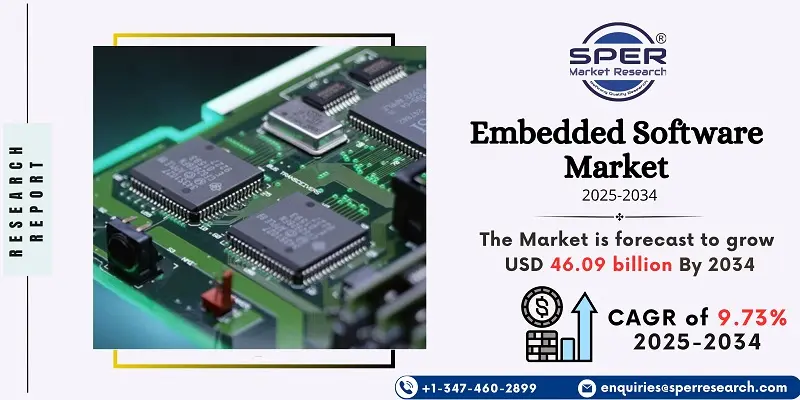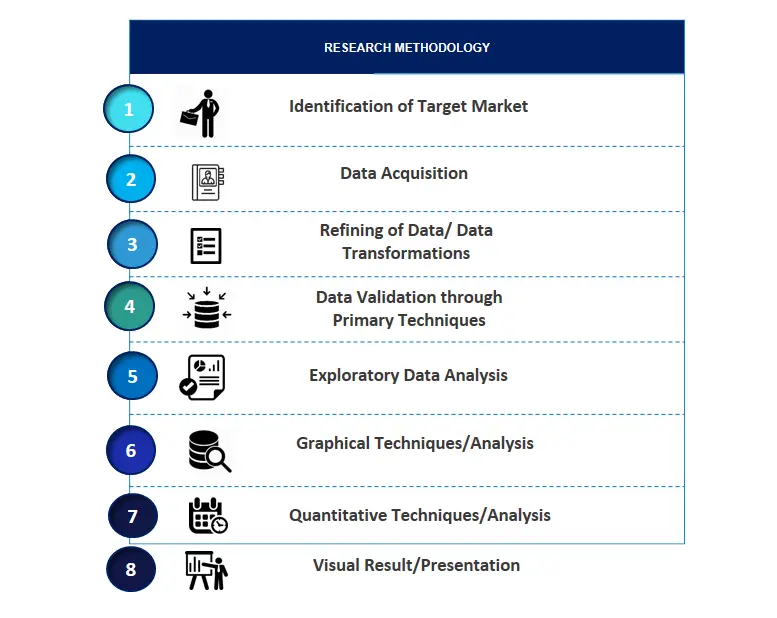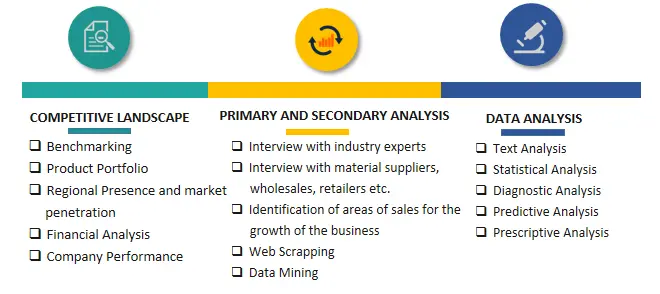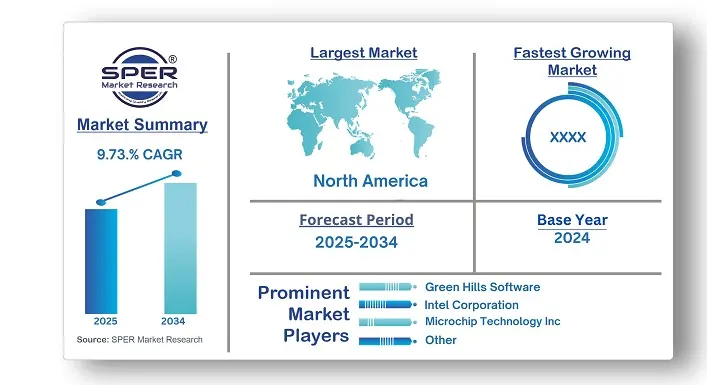
Embedded Software Market Size, Share and Growth 2034
Embedded Software Market Growth, Size, Trends Analysis - By Operating System, Functionality, By Vertical - Regional Outlook, Competitive Strategies and Segment Forecast to 2034
| Published: Oct-2025 | Report ID: SEMI2598 | Pages: 1 - 236 | Formats*: |
| Category : Semiconductor and Electronics | |||

| Report Metric | Details |
| Market size available for years | 2021-2034 |
| Base year considered | 2024 |
| Forecast period | 2025-2034 |
| Segments covered | By Operating System, Functionality, By Vertical |
| Regions covered | North America, Latin America, Asia-Pacific, Europe, and Middle East & Africa |
| Companies Covered | Green Hills Software, Intel Corporation, Microchip Technology Inc, Microsoft, NXP Semiconductors, Renesas Electronics Corporation, Siemens, STMicroelectronics, Texas Instruments Incorporated, Wind River Systems, Inc. |
- Global Embedded Software Market Size (FY 2021-FY 2034)
- Overview of Global Embedded Software Market
- Segmentation of Global Embedded Software Market By Operating System (General Purpose Operating System, Real-time Operating System, Others)
- Segmentation of Global Embedded Software Market By Functionality (Standalone Systems, Real-Time Embedded Systems, Mobile Embedded Systems, Networked Embedded Systems)
- Segmentation of Global Embedded Software Market By Vertical (Computing Devices, Consumer Electronics, Industrial Automation, Automotive, Manufacturing, Telecommunications, Others)
- Statistical Snap of Global Embedded Software Market
- Expansion Analysis of Global Embedded Software Market
- Problems and Obstacles in Global Embedded Software Market
- Competitive Landscape in the Global Embedded Software Market
- Details on Current Investment in Global Embedded Software Market
- Competitive Analysis of Global Embedded Software Market
- Prominent Players in the Global Embedded Software Market
- SWOT Analysis of Global Embedded Software Market
- Global Embedded Software Market Future Outlook and Projections (FY 2025-FY 2034)
- Recommendations from Analyst
- 1.1. Scope of the report
- 1.2. Market segment analysis
- 2.1. Research data source
- 2.1.1. Secondary Data
- 2.1.2. Primary Data
- 2.1.3. SPERs internal database
- 2.1.4. Premium insight from KOLs
- 2.2. Market size estimation
- 2.2.1. Top-down and Bottom-up approach
- 2.3. Data triangulation
- 4.1. Driver, Restraint, Opportunity and Challenges analysis
- 4.1.1. Drivers
- 4.1.2. Restraints
- 4.1.3. Opportunities
- 4.1.4. Challenges
- 5.1. SWOT Analysis
- 5.1.1. Strengths
- 5.1.2. Weaknesses
- 5.1.3. Opportunities
- 5.1.4. Threats
- 5.2. PESTEL Analysis
- 5.2.1. Political Landscape
- 5.2.2. Economic Landscape
- 5.2.3. Social Landscape
- 5.2.4. Technological Landscape
- 5.2.5. Environmental Landscape
- 5.2.6. Legal Landscape
- 5.3. PORTERs Five Forces
- 5.3.1. Bargaining power of suppliers
- 5.3.2. Bargaining power of buyers
- 5.3.3. Threat of Substitute
- 5.3.4. Threat of new entrant
- 5.3.5. Competitive rivalry
- 5.4. Heat Map Analysis
- 6.1. Global Embedded Software Market Manufacturing Base Distribution, Sales Area, Product Type
- 6.2. Mergers & Acquisitions, Partnerships, Product Launch, and Collaboration in Global Embedded Software Market
- 7.1. General Purpose Operating System (GPOS)
- 7.2. Real-time Operating System (RTOS)
- 7.3. Others
- 8.1. Standalone Systems
- 8.2. Real-Time Embedded Systems
- 8.3. Mobile Embedded Systems
- 8.4. Networked Embedded Systems
- 9.1. Computing Devices
- 9.2. Consumer Electronics
- 9.3. Industrial Automation
- 9.4. Automotive
- 9.5. Manufacturing
- 9.6. Telecommunications
- 9.7. Others
- 10.1. Global Embedded Software Market Size and Market Share
- 11.1. Asia-Pacific
- 11.1.1. Australia
- 11.1.2. China
- 11.1.3. India
- 11.1.4. Japan
- 11.1.5. South Korea
- 11.1.6. Rest of Asia-Pacific
- 11.2. Europe
- 11.2.1. France
- 11.2.2. Germany
- 11.2.3. Italy
- 11.2.4. Spain
- 11.2.5. United Kingdom
- 11.2.6. Rest of Europe
- 11.3. Middle East and Africa
- 11.3.1. Kingdom of Saudi Arabia
- 11.3.2. United Arab Emirates
- 11.3.3. Qatar
- 11.3.4. South Africa
- 11.3.5. Egypt
- 11.3.6. Morocco
- 11.3.7. Nigeria
- 11.3.8. Rest of Middle-East and Africa
- 11.4. North America
- 11.4.1. Canada
- 11.4.2. Mexico
- 11.4.3. United States
- 11.5. Latin America
- 11.5.1. Argentina
- 11.5.2. Brazil
- 11.5.3. Rest of Latin America
- 12.1. Green Hills Software
- 12.1.1. Company details
- 12.1.2. Financial outlook
- 12.1.3. Product summary
- 12.1.4. Recent developments
- 12.2. Intel Corporation
- 12.2.1. Company details
- 12.2.2. Financial outlook
- 12.2.3. Product summary
- 12.2.4. Recent developments
- 12.3. Microchip Technology Inc
- 12.3.1. Company details
- 12.3.2. Financial outlook
- 12.3.3. Product summary
- 12.3.4. Recent developments
- 12.4. Microsoft
- 12.4.1. Company details
- 12.4.2. Financial outlook
- 12.4.3. Product summary
- 12.4.4. Recent developments
- 12.5. NXP Semiconductors
- 12.5.1. Company details
- 12.5.2. Financial outlook
- 12.5.3. Product summary
- 12.5.4. Recent developments
- 12.6. Renesas Electronics Corporation
- 12.6.1. Company details
- 12.6.2. Financial outlook
- 12.6.3. Product summary
- 12.6.4. Recent developments
- 12.7. Siemens
- 12.7.1. Company details
- 12.7.2. Financial outlook
- 12.7.3. Product summary
- 12.7.4. Recent developments
- 12.8. STMicroelectronics
- 12.8.1. Company details
- 12.8.2. Financial outlook
- 12.8.3. Product summary
- 12.8.4. Recent developments
- 12.9. Texas Instruments Incorporated
- 12.9.1. Company details
- 12.9.2. Financial outlook
- 12.9.3. Product summary
- 12.9.4. Recent developments
- 12.10. Wind River Systems, Inc
- 12.10.1. Company details
- 12.10.2. Financial outlook
- 12.10.3. Product summary
- 12.10.4. Recent developments
- 12.11. Others
SPER Market Research’s methodology uses great emphasis on primary research to ensure that the market intelligence insights are up to date, reliable and accurate. Primary interviews are done with players involved in each phase of a supply chain to analyze the market forecasting. The secondary research method is used to help you fully understand how the future markets and the spending patterns look likes.
The report is based on in-depth qualitative and quantitative analysis of the Product Market. The quantitative analysis involves the application of various projection and sampling techniques. The qualitative analysis involves primary interviews, surveys, and vendor briefings. The data gathered as a result of these processes are validated through experts opinion. Our research methodology entails an ideal mixture of primary and secondary initiatives.



Frequently Asked Questions About This Report
PLACE AN ORDER
Year End Discount
Sample Report
Pre-Purchase Inquiry
NEED CUSTOMIZATION?
Request CustomizationCALL OR EMAIL US
100% Secure Payment






Related Reports
Our Global Clients
Our data-driven insights have influenced the strategy of 200+ reputed companies across the globe.























